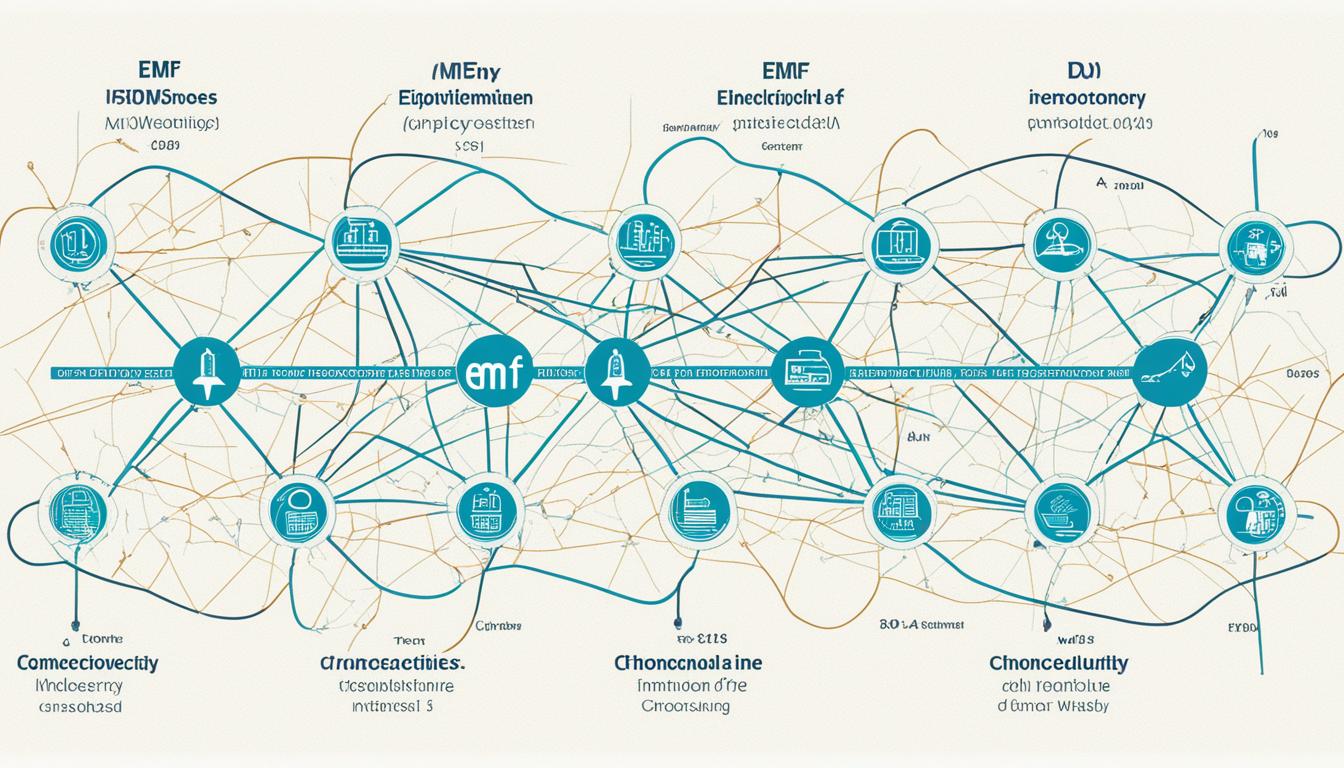Disclosure: This Post Contains Affiliate Links; We earn a commission on purchases.
Welcome to our guide on electromagnetic fields (EMFs)! In today’s technology-driven world, it’s important to understand the basics of EMF awareness and how they impact our daily lives. From the electromagnetic fields generated by the Earth’s magnetic field to those produced by our electrical devices, EMFs surround us.
EMFs consist of invisible electric and magnetic fields, which can be generated by natural phenomena as well as human activities involving electricity. Various sources, such as mobile phones, power lines, and computer screens, emit EMFs that fall into different frequency ranges.
By delving into the world of EMFs, we can become more aware of their presence and potential impact on our health. Let’s explore the fundamentals of EMFs and gain a better understanding of these invisible fields that surround us every day.
Key Takeaways:
- EMFs are a combination of invisible electric and magnetic fields generated by natural phenomena and human activities involving electricity.
- Sources such as mobile phones, power lines, and computer screens emit EMFs in different frequency ranges.
- Understanding EMFs can help us become aware of their presence and potential impact on our health.
- By learning about EMF basics, we can make informed choices to mitigate potential risks.
- Stay tuned for the upcoming sections where we’ll explore the health risks, types of EMFs, and safety measures to minimize exposure.
Health Risks of Electromagnetic Fields
Scientific studies have extensively reassessed the health risks associated with electromagnetic fields (EMFs). These studies evaluate the potential effects of EMF exposure on individuals in their daily lives, as well as conduct laboratory experiments on human volunteers, animals, and cell cultures. By gathering evidence and analyzing the data, researchers aim to determine whether there is a causal link between EMF exposure and adverse health effects.
The assessment takes into consideration various factors, such as the strength of the health effect, the level of risk at different exposure levels and patterns, and plausible mechanisms of how EMFs could potentially cause effects. While some studies have suggested a weak potential link between higher EMF field strengths and an increased risk of childhood leukemia, currently, there is no conclusive evidence establishing a direct connection between EMF exposure and adult cancers like brain cancer or breast cancer.
“Scientific studies reassessing the health risks of electromagnetic fields have helped shed light on the potential effects of EMF exposure, especially in relation to diseases like childhood leukemia. However, it is crucial to note that the evidence is not yet definitive when it comes to establishing a link between EMF exposure and adult cancers like brain cancer or breast cancer.” – Dr. Lisa Adams, EMF Researcher
While there are ongoing discussions and research regarding the impact of EMFs on human health, it is essential to stay informed and follow updates from reputable organizations and scientific studies. Understanding EMF radiation and its possible health effects is a crucial step in making informed decisions about minimizing exposure and implementing appropriate safety measures.
Key Takeaways:
- Scientific studies have reassessed the health risks associated with electromagnetic fields (EMFs).
- The assessment evaluates potential effects on individuals exposed to EMFs in their daily lives, as well as data from laboratory experiments.
- No conclusive evidence establishes a link between EMF exposure and adult cancers like brain cancer or breast cancer.
- Staying informed and following updates from reputable organizations is recommended to make informed decisions.
Types of Electromagnetic Fields
Electromagnetic fields can be classified into two main types: non-ionizing and ionizing. Understanding these types is crucial to assess potential risks and take appropriate precautions.
Non-Ionizing Fields:
The non-ionizing fields include extremely low frequency (ELF), radio frequency (RF), microwaves, and visible light. These frequencies are generally considered harmless to humans and are emitted by various sources such as:
- Power lines
- Electrical appliances
- Wireless networks
- Cell phones
- Microwave ovens
Non-ionizing fields have become an integral part of our daily lives, with advancements in technology and the widespread use of electronic devices. However, while they are generally safe, it is still important to understand their associated frequencies and potential effects.
Ionizing Fields:
Ionizing fields have the potential to cause cellular and DNA damage with prolonged exposure. These fields include ultraviolet (UV) radiation, X-rays, and gamma rays. Unlike non-ionizing fields, ionizing fields have higher energy levels and can strip electrons from atoms or molecules.
It is crucial to note that ionizing fields, such as X-rays and gamma rays, are typically only encountered in specific situations, such as medical imaging or industrial settings. These fields require specific safety measures and should only be used when necessary, with proper shielding and protection.
Comparison Table:
| Field Type | Examples of Sources | Frequency Range | Potential Health Effects |
|---|---|---|---|
| Non-Ionizing Fields | Power lines, cell phones, microwave ovens | Extremely low frequency (ELF) | No known adverse health effects at typical exposure levels |
| Non-Ionizing Fields | Wi-Fi networks, Bluetooth devices | Radio frequency (RF) | No known adverse health effects at typical exposure levels |
| Ionizing Fields | X-rays, gamma rays | High-frequency electromagnetic waves | Potential for cellular and DNA damage with prolonged exposure |
Understanding the different types of electromagnetic fields and their associated frequencies allows individuals to make informed decisions, minimize potential risks, and ensure appropriate safety measures are in place.

Invisible Exposure to Electromagnetic Fields
Electromagnetic radiation or fields (EMFs) are omnipresent in our environment, both naturally and artificially. They include visible light, communication waves, x-rays, gamma rays, and more. While we cannot “see” artificial EMFs like we can see visible light, it is important to recognize that our bodies are still being exposed to them and that they may have an impact on us.
With the rapid advancements in technology and the increasing use of EMFs in our daily lives, it becomes crucial to take safety measures to minimize exposure. This can include:
- Using shielding devices: There are various shielding devices available in the market that can help reduce the exposure to EMFs. These devices can be used on electronic devices or even on personal accessories like cell phone cases.
- Keeping a safe distance: Maintaining a safe distance from sources of high EMF can significantly reduce the exposure. For example, when using a laptop or mobile phone, keep a safe distance between the device and your body.
- Following guidelines: Organizations like the World Health Organization provide guidelines on EMF safety measures. Staying informed and following these guidelines can help protect yourself from excessive EMF exposure.
“EMF safety measures play a crucial role in minimizing invisible exposure to electromagnetic fields.”

By taking these safety measures, you can reduce your exposure to EMFs and potentially lower any associated health risks. It is important to prioritize your well-being and make informed choices when it comes to invisible exposure to electromagnetic fields.
Understanding Light Waves and Photons
All forms of electromagnetic radiation, including visible light, are light waves. These waves consist of energy particles known as photons. Traveling at the speed of light, photons carry energy depending on their frequency. The electromagnetic spectrum encompasses a wide range of light waves, spanning from low to high frequency.
While humans are most familiar with visible light waves, other forms of light exist within the electromagnetic spectrum. These include radio waves, microwaves, infrared, ultraviolet, X-rays, and gamma rays. Each type of light wave has its own characteristic frequency and energy level.
The frequency of a light wave determines its energy. Understanding this relationship is crucial in comprehending how different types of light waves interact with our bodies and the environment. By studying the properties of light waves and photons, we gain valuable insights into the diverse range of electromagnetic radiation present in our daily lives.
The Electromagnetic Spectrum
Let’s take a closer look at the different types of light waves that make up the electromagnetic spectrum in the table below:
| Type of Light Wave | Frequency Range | Applications |
|---|---|---|
| Radio Waves | 30 kHz – 300 GHz | Wireless communication, broadcasting |
| Microwaves | 300 MHz – 300 GHz | Microwave ovens, radar systems |
| Infrared | 300 GHz – 400 THz | Night vision, remote controls |
| Visible Light | 400 THz – 789 THz | Human vision |
| Ultraviolet | 789 THz – 30 PHz | Disinfection, tanning, forensic analysis |
| X-rays | 30 PHz – 30 EHz | Medical imaging, airport security |
| Gamma Rays | 30 EHz – 300 EHz | Radiotherapy, nuclear imaging |
As shown in the table, each type of light wave has distinct applications and frequencies within the electromagnetic spectrum. Understanding the range and usage of these waves provides a comprehensive overview of the diverse world of electromagnetic radiation.
The Photon and its Energy
A photon is a massless energy particle created by natural or artificial events. In the sun, for example, nuclear fusion processes generate photons that travel through space and reach the Earth as light waves. Similarly, when electrical current passes through a lightbulb filament, it excites electrons, causing the release of photons. These photons carry energy and contribute to the formation of electromagnetic fields.
The energy of a light wave is directly related to the frequency of its photons. According to the Planck equation, the energy of a single photon, E, is equal to the product of its frequency, v, and the Planck constant, h: E = h * v.
Understanding how photons are created and their energy content is crucial in comprehending the effects of different types of light waves, including the invisible electromagnetic fields (EMFs) we encounter in our daily lives.
Illustrative Example:
| Photon Frequency Range | Energy Level |
|---|---|
| Radio Waves | Lowest energy photons |
| Visible Light | Intermediate energy photons |
| X-rays and Gamma rays | Highest energy photons |
By understanding the relationship between photons and the energy they carry, we can better evaluate the potential impact of different types of light waves, including the invisible EMFs present in our environment.
Assessing EMF Risks and Taking Precautions
To minimize potential risks associated with Electromagnetic Fields (EMFs), it is important to take certain precautions. By following these EMF protection tips and safety measures, you can reduce your exposure and promote a healthier environment for yourself and your family.
Reduce Wireless Device Usage
One of the main sources of EMF exposure is wireless devices such as smartphones, tablets, and laptops. To minimize your exposure, consider reducing your usage of these devices and using them only when necessary.
When using wireless devices, try to maintain a safe distance between your body and the device. This can be achieved by using hands-free options like headphones or speaker mode when making phone calls and placing your device on a desk or table instead of directly on your body.
Avoid Prolonged Exposure to High EMF Sources
Certain sources of EMFs, such as power lines and electrical transformers, can emit higher levels of EMF radiation. To reduce your exposure, try to avoid spending long periods of time in close proximity to these sources.
If you live or work near power lines or other high EMF sources, consider rearranging your living or work space to minimize your exposure. For example, you can rearrange furniture to create a safe distance between you and the source of EMFs.
Create a Low-EMF Environment
Creating a low-EMF environment in your home or workspace can help minimize your overall exposure. Here are some steps you can take:
- Keep electronic devices and appliances at a distance from where you spend the most time, such as your bed or desk.
- Turn off devices that are not in use to reduce unnecessary EMF exposure.
- Use grounding techniques, such as grounding mats or grounding shoes, to help neutralize EMF radiation.
Use EMF Shielding Devices
EMF shielding devices can help reduce your exposure to EMFs. These devices can include EMF protective clothing, cell phone radiation shields, or covers for electronic devices that block or absorb EMF radiation.
When choosing shielding devices, make sure to do thorough research and select products that have been tested and certified by reputable organizations.
Stay Informed and Follow Guidelines
It is important to stay informed about current research and guidelines provided by reputable organizations such as the World Health Organization (WHO). These organizations regularly evaluate the potential health effects of EMFs and provide recommendations for minimizing exposure.
By staying informed and following these guidelines, you can make conscious choices to protect yourself and your family from excessive EMF exposure.
Remember, while it’s important to be aware of EMF risks, there is currently no conclusive evidence of significant health risks from typical EMF sources. By taking these EMF protection tips and safety measures, you can help create a safer environment for yourself and your loved ones.
Conclusion
Understanding and raising awareness about electromagnetic fields (EMFs) is essential in today’s technology-driven world. While there are concerns and myths related to EMF exposure, research and assessments have consistently shown no conclusive evidence of significant health risks from typical EMF sources.
It is important to differentiate between ionizing and non-ionizing radiation and to assess exposure levels to make informed decisions. By understanding the basics of EMFs, the different types of fields, and the relationship between light waves and photons, we can debunk common misconceptions about EMF radiation and take appropriate safety measures.
Remember, the key to navigating EMF exposure is knowledge. Stay informed about current research and guidelines provided by reputable organizations like the World Health Organization. By understanding EMFs and separating fact from fiction, we can embrace technology while ensuring our well-being and peace of mind.
Source Links
- https://www.niehs.nih.gov/health/topics/agents/emf
- https://ec.europa.eu/health/scientific_committees/opinions_layman/en/electromagnetic-fields/l-2/1-electromagnetic-fields.htm
- https://medium.com/@nathaniel01/demystifying-emf-a3091b5f9d6d

Subscribe to Our Newsletter










